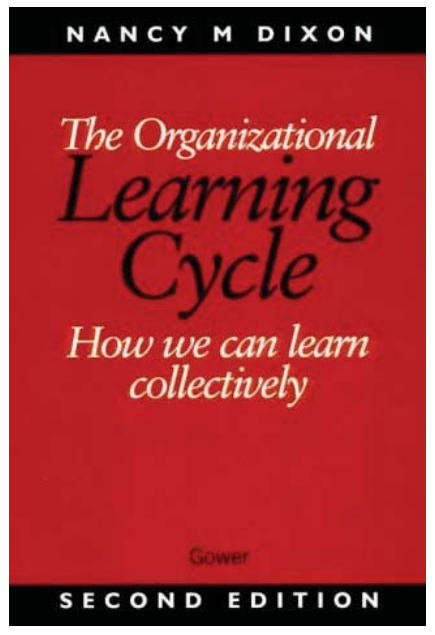A review of The Organizational Learning Cycle: How We Can Learn Collectively
Written by Nancy Dixon, published by Gower Pub. Co., 2nd edition ISBN 0566080583 (1999)
Bill Godfrey

Introduction
For those who own the 1st Edition, some very important new material has been added:
- a new chapter on ‘The Hallways of Learning’ which deals with the vital subject of making meaning out of our experience. It takes in and expands the previous Chapter 3.
- The chapter previously called “Theory and Structure” has been renamed “A Theoretical Framework” and is now supported with two new chapters on infrastructure for learning and measuring learning.
- There is also a new chapter on the responsibilities of members in an organization that is learning.
I judge that the new material and additional insights fully justify buying a new copy even if you have the old.)
When this classic in its field was first published in 1994, it immediately became a definitive text on organizational learning. The second edition builds on the first, with five new or revised chapters and incorporation of useful case study material of successful organizational learning. The last five years have seen many useful additions to the literature, but Nancy Dixon’s book remains my first choice for straightforward, helpful and thorough coverage of the issues and practice.
The book is practical, illuminating and wide ranging, and with quite enough examples to give it life for those who are seeking practical solutions to practical problems. I highly recommend it to everyone directly concerned with enhancing learning in their organization (is there anyone who is not or should not be?). Even if you have no time for reading, you should at least read the Preface and Introduction.
It is worth quoting the four main themes listed in the Preface in full:
Learning is part of work and work involves learning; these are not separate functions but intertwined; the separation we have made of them is artificial and often does not serve us well.
Learning is not only or even primarily about obtaining correct information or answers from knowledgeable others; it is fundamentally about making meaning out of the experience we and others have in the world.
Organizational learning results from intentional and planned efforts to learn. Although it can and does occur accidentally, organizations cannot afford to rely on learning through chance.
As a collective we are capable of learning our way to the answers we need to address our difficult problems. It is ourselves we must rely on for these answers rather than experts, who can, at best, only provide us with answers that have worked in the past.
For a great many organizations these principles call for a major shift from current practice. Organizational learning is about the ability to change and adapt:
The key to organizational learning is not only the ability of the organization to transform itself and its environment, but to do so continuously...
And organizational learning is:
the intentional use of learning processes at the individual, group and system level to continuously transform the organization in a direction that is increasingly satisfying to its stakeholders.
A major premise of this book is that learning is the construction and re-construction of meaning and as such it is a dynamic process. Accumulated knowledge, then, is of less significance than are the processes needed to continuously revise or create knowledge.
All this is in support of the thesis that, for an organism or an organization to survive, its rate of learning must be equal to or greater than the rate of change in its environment.
The whole book is based round use of the learning cycle, variously known as the Kolb cycle and, among disciples of Deming, the Deming cycle. The discussion is developed round application of the cycle at the individual and the organizational level, and the interactions between the two levels.
There are four steps in the cycle and Dixon stresses that they are interdependent and mutually supportive. Organizational learning depends on the consistent application of all four steps, with sufficient time and attention devoted to each step. She observes, and m observation is the same, that one of the most common failings in organizations is to focus on one or two of the four elements, while neglecting the others. The result is invariably disappointment. N or does she fail to point out what a radical challenge this poses to ways of thinking which are deeply imbued in most people in senior positions.
The book is grounded in the Kolb cycle, in Argyris’s work on mental models and defensive routines, and in the principles of action learning, which was apparently founded by R. Revans some fifty years ago (though I suspect that the principles are a great deal older than that). To oversimplify, it is the thesis that learning, in the sense of improved capacity for effective action, takes place only in the context of action, a point which Nancy Dixon develops into an argument for situating learning activity primarily in real work.
This last point is dear to my heart—from observation. However, while it is increasingly talked about, practice in most organizations is still mostly concerned with training in a class room, with quite inadequate attention given to designing work for learning. Perhaps this book will give a further nudge away from training and towards learning. If so, it will have served our society well.
The book is well-organized, well-summarized, and well-referenced, which makes it very accessible.